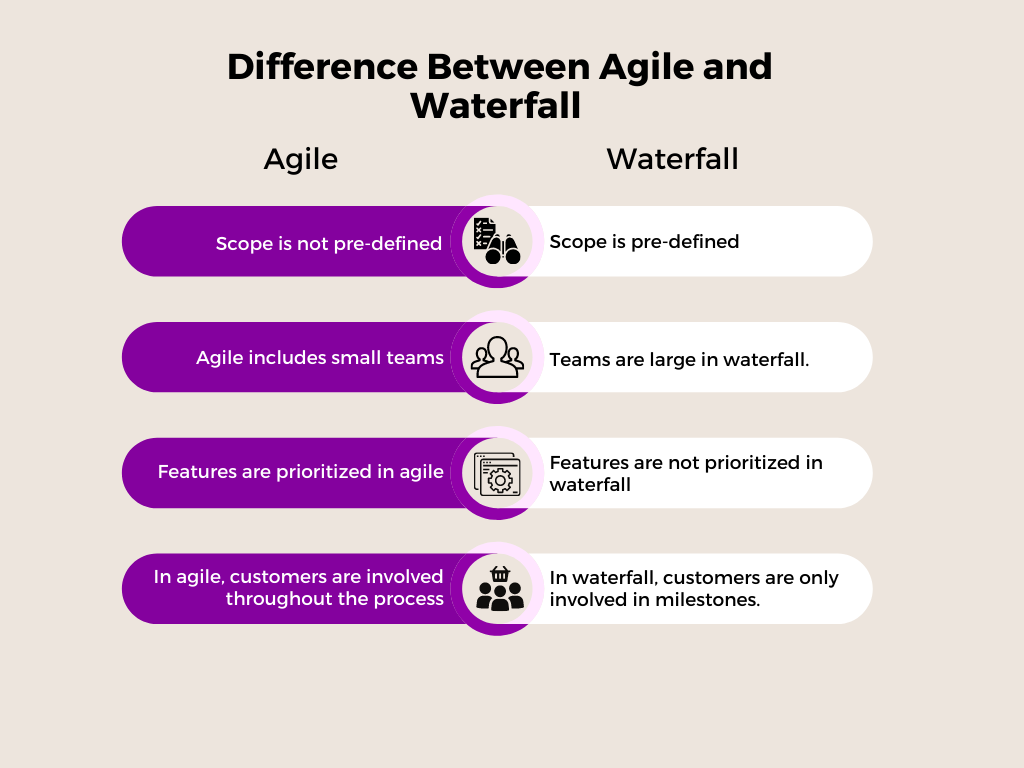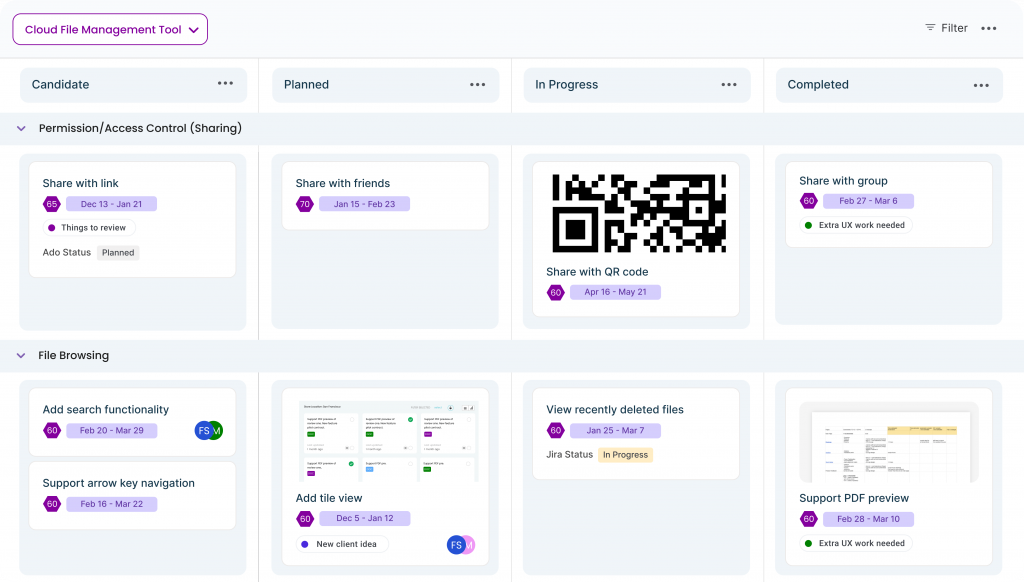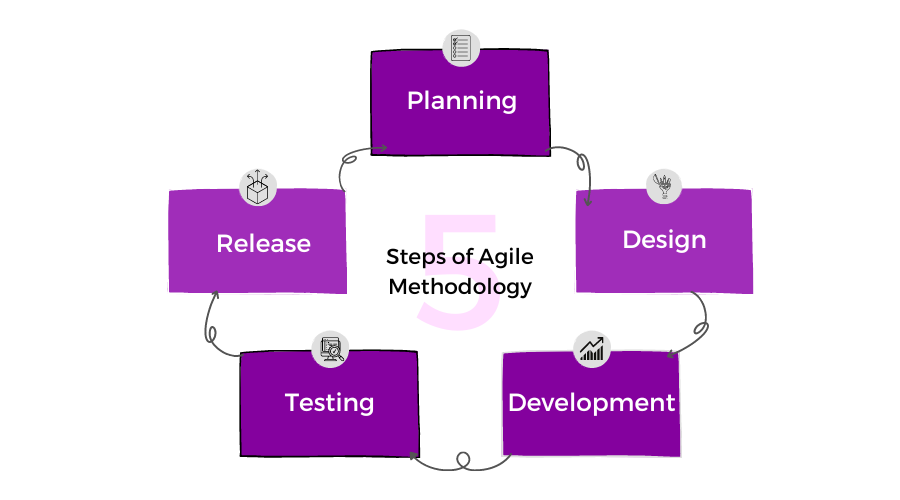What Is Agile Methodology? An Ultimate Guide (2023)

This article covers:
- What Is Agile Methodology?
- What Are the 4 Key Types of Agile Frameworks in Use Today?
- Agile Development Life-Cycle
- Best Practice Principles for Agile Development
- What Are the Steps Included in Agile Methodology?
- How Should Companies Incorporate Agile Methodology Into Their Initiatives?
- What Are the Advantages of Agile Methodology?
- What Are the Disadvantages of Agile Methodology?
What Is Agile Methodology?
Agile is a developmental software method that sets a framework for development work in iterations based on the end-user’s requirements.
Agile is a customer-centric approach to development where customer feedback on the existing product version plays a crucial role. That is in developing the next version.
The waterfall method takes a linear approach to development and completes it fully. However, agile focuses on delivering based on established user needs.
It also aims at updating it in iterations to stay up to date on market and user behaviors.

Bonus: Click here to learn more about the differences between agile and waterfall development methods.
Some of the key advantages of using the agile method for development are:
- It reduced resource wastage from long development cycles that risk producing outdated products and features.
- Agile teams are more capable of quickly responding to customer feedback and market needs, hence is a customer-centric framework.
- Development teams are in alignment and focused only on the build’s delivery, which reduces work-in-progress and issues of bottlenecks and backlogs.
- Agile teams are leaner since the development is in iterative cycles. It drastically reduces the need for more human resources.
- There is a greater team collaboration and work-ownership arising from the agile principles of self-accountability in work deliveries.
What Are the 4 Key Types of Agile Frameworks in Use Today?
While agile is the lynch-pin methodology, it has grown into several specialized frameworks, each focusing on improving a stage of the development cycle.
Below are four vital agile frameworks in use today:
- Kanban: It focuses on streamlining development work by reducing the amount of work-in-progress (WIP).

- Scrum: It focuses on building collaboration-driven team independence. Each team member takes ownership of their work at an individual and group level with the most negligible supervision needed to get deliveries on time.
- Feature-driven development: It prioritizes feature requests from customers and clients through customer-centric and value-focused developmental philosophies.
- Crystal/Lean: It focuses on increasing the capacity for individual members to take decisions autonomously for faster, de-centralized day-to-day decision-making. It also seeks to reduce bottlenecks from decision delays.
Agile Development Life-Cycle
Feasibility Testing
Feasibility studies are fundamental before considering any product development method, and agile is no different.
Agile focuses on user satisfaction at every iteration. Testing the request features for cost-benefit analysis is key to each sprint’s decision-making.
Team Alignment
Once a product/ feature has passed feasibility tests, the following step to any agile framework is team alignment on all aspects of development, DevOps, and quality assurance (QA).
This step determines the team’s capacity to sync with each other’s work and responsibilities, clarify the utility and value of the work, and collaborate effectively to deliver the final sprint on time.

Product Definition
“Creating product vision, feature roadmap, and prioritization” – Product managers create a product and feature roadmap that is both compelling and achievable.
They use their in-depth understanding of the target customer’s needs, the engineering team’s capabilities, and the technologies available. Using this understanding, they create a product backlog to ship the right features at the right time.
Bonus: Do you want to know how to prioritize and manage your backlog effectively? Click here.
Development and QA
Once the teams are aligned, development work begins as per the sprint plan. Once handed over from the developers, the updates go to QA teams for quality tests.
If QA clears the update, it proceeds to user-testing. Else it goes back to the developers with notes on which components did not pass the test and why.
User-testing
Once QA clears the product/product update, it passes to external user testing. These users may still be internally employed and compose a panel of 2 or more people.
While QA only looks for compatibility as per the original design, user testing seeks to identify issues in experience gaps, such as inadequate navigation, aesthetics, intuitiveness, and ease of use. A product may return to developers for final patches based on user-test results.
Production
The product/update iteration goes into production on a planned day. This day is typically chosen on downtime when minor users are on the platform.
This practice avoids adversely affecting the experience for the maximum number of users. You can reduce the update time as much as possible.
Monitoring and Customer Feedback
Once produced, the product is closely monitored for issues for at least 24-48 hours.
Even after this period, teams must be set up to monitor error reports and line them up for the next sprint. Some critical errors may be pushed out in a mid-cycle build, while you can prioritize others in upcoming sprints.
At the same time, the customer experience and service teams watch the communication lines for customer feedback. They may actively seek customer feedback after using the updated product for a specific period.
This feedback is then collected, tested for feasibility, and entered into the development cycle.
Bonus: Click here to learn about best practices and solutions for streamlined customer feedback management.
Best Practice Principles for Agile Development
The below best practices come from the central tenants for each framework that uses the agile methodology. That, in turn, improves the implementation of the method itself.
Limit Work-in-Progress To Streamline Continuous Development
Limiting work-in-progress in any agile development process is a series of steps to reduce the current workload on developers.
That is, till it reaches a point where development can occur efficiently (from an ROI and business goals perspective.)
Meanwhile, not clogging the production pipeline.
The goal is a sustainable and scalable production system that can work independently without requiring constant fixes and issue resolutions to clear bottlenecks and backlogs.
It allows the product managers to identify weaknesses in the pipeline and resolve them or reduce the workload until it functions adequately.
It is tough to accomplish when you already have a clogged production machine.
Reducing the workload on the more extensive production machine enables you to pressure-test special teams and developers and identify where the issue lies.
Designate a Meeting/Scrum Master
Any team using an agile framework may find it beneficial to have a scrum-type meeting at least once a week.
That is, invariant of whether you aim for a scrum method of development with daily scrum meetings conducted by the scrum master.
The scrum meeting is a quick check on planned items, work-completed, work-in-progress on that day/week, bottlenecks, backlogs, and upcoming work.
Each member is given 2-3 minutes for a quick recall before moving on to the next person.
A scrum ensures that you meet the commitment points while allowing teams and members to work independently once the meeting is over.
Enable Cross-team Collaboration With Tech-stack
Enabling the various teams involved in the final sprint development ensures streamlined product roadmap delivery.
Since agile works on the philosophy of individual ownership of work, collaboration will be vital to ensuring output quality.
Teams mainly work remotely in the post-covid lockdown world, and having the right technology stack has become necessary.
Companies today can choose point solutions for collaboration and task management solutions or can aim for more extensive product management software.
Use Visual Aids for Roadmapping and Progress Management
Visual boards such as Kanban and Scrum boards may be physical or digital for product roadmapping.
It ensures team alignment on tasks, in-progress, and backlogs.
Kanban board can accelerate how you use your product roadmap software.
To understand more about our Kanban functionalities, request a demo session right away.
Humans are proven to be driven by visuals, and having a visual chart that maps the plan and progress brings immense clarity.
Since most employees work remotely, a physical board may no longer suffice, even for small teams.
Product managers need to prioritize acquiring the right technology tool for their team.
What Are the Steps Included in Agile Methodology?
The agile methodology is a process for software development that enables teams to respond quickly to changes in customer requirements.
It is an iterative and incremental process that allows for the continuous delivery of working software.
It is a lightweight process that allows rapid response to change and customer feedback. The agile methodology has been in practice for over two decades, with many different flavors.
The agile methodology relies on frameworks and practices that utilize early and continuous delivery of incremental product features to customers.
Agile encourages flexible responses to changes in market needs to ensure the value of the developed products and services.
This software development method focuses on producing an early, continuously evolving product that delivers business value through customer feedback.
The agile methodology has five steps:
- Planning: In the planning phase, the agile team selects the overall product vision, decides what to build next, and when, and estimates the development cost.
- Design: The design phase plans how to build the requirements into a product where you break down the product using a backlog technique. The breaking down identifies how you plan to organize and develop the product.
- Development: The development phase becomes a repetition of specific tasks until you complete the project. These include gathering requirements, designing individual components, coding, unit testing, integration, and acceptance testing.
- Testing: This phase involves the designers, client testing, and prototype analysis. The testing phase usually occurs before the programming phase but can occur with continuous feedback during development. You should test in a natural environment to be valuable. As changes occur, you need to determine if they are significant enough. It will compel you to scrap what you have and start over.
- Release: This is the last stage of the agile methodology. It is very significant. Ideally, it should be early and often. Put your product in the hands of users to receive feedback and make improvements. Think of each release as one step forward in the path of continuous improvement.

The steps are repeated as necessary until you complete the project.
How Should Companies Incorporate Agile Methodology Into Their Initiatives?
The agile methodology is an iterative and incremental software development process that allows for the rapid delivery of high-quality software.
The outline of the first agile methodology was in the Agile Manifesto in 2001.
‘Should agile methodology be capitalized?’ was one of the popular questions before the Agile Manifesto. This outline marked capitalizing on the methodology. It highlighted four fundamental values:
- Individuals and interactions over processes and tools.
- Working software over comprehensive documentation.
- Customer collaboration over contract negotiation.
- Responding to change over following a plan.
Since its inception, software developers have widely adopted the agile methodology. They have begun using it in other industries, such as marketing and product management.
Here are a few additional steps that companies can take to incorporate agile into their initiatives:
- Use sprints to prioritize and manage tasks.
- Allow for regular feedback and course corrections.
- Encourage collaboration among team members.
What Are the Advantages of Agile Methodology?
The agile methodology has numerous benefits. There have been many developments to this methodology over the years. All of the alterations have only made it better.
Now let’s understand the advantages in detail.
- It’s an adaptive approach popular in fast-paced industries, such as software development, product design, and marketing.
- The agile methodology, called sprints, aims to deliver working software incrementally in short cycles. It lets stakeholders see the project’s progress and provide feedback early and often.
- The agile methodology is an iterative software development process that enables teams to respond to change quickly. It has been gaining popularity over the past few years as businesses have shifted to a more agile way of working.
- The main advantage of the agile methodology is that it allows businesses to be more flexible and adaptable. The fast pace of change in today’s world means that companies need to be able to respond quickly to new opportunities and challenges. The agile methodology enables them to do just that.
What if we told you there is an agile product management software that is your one-stop solution for all your needs?
What Are the Disadvantages of Agile Methodology?
The agile methodology has become the most popular product management methodology globally.
It works the best if implemented with a product roadmap software or a product manager tool.
However, it has its set of shortcomings.
Some of the main disadvantages of agile include the following:
- The agile methodology can be disruptive to traditional management structures and working methods. Since agile methods depend on incremental and iterative change, teams can often be chaotic. They try to implement new changes, leading to frustration and conflict among team members.
- The agile methodology can be very demanding on team members, who often have to work long hours and weekends.
- The agile methodology can disrupt company culture, as it often favors a more flexible, less bureaucratic way of working.
- Agile methodology can be overwhelming for team members unfamiliar with it.
You may also be interested in:
- Do You Use Agile or Waterfall Development
- What Is An Agile Release Train?
- What Is Agile Leadership? [Definition and Overview]
- What is Agile Transformation, and how to do it?
- What Is Disciplined Agile Delivery? A Complete Overview
- Agile Marketing: Everything You Need to Know About This Essential Approach
- Top 9 Scrum Master Certifications and Their Value
- Most Popular Agile Certifications To Consider
- How to Build an Agile Culture?
- What Is Agile Spike? Definition, Types and Examples
